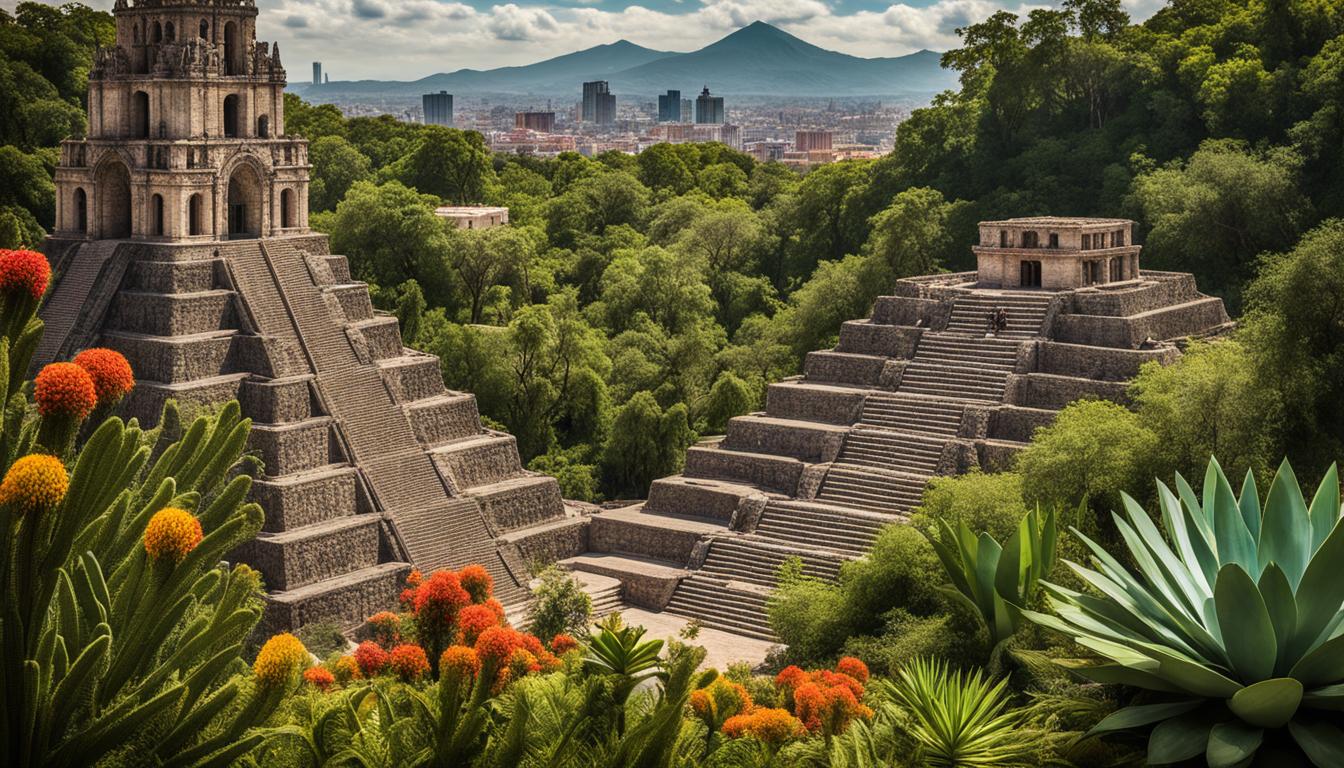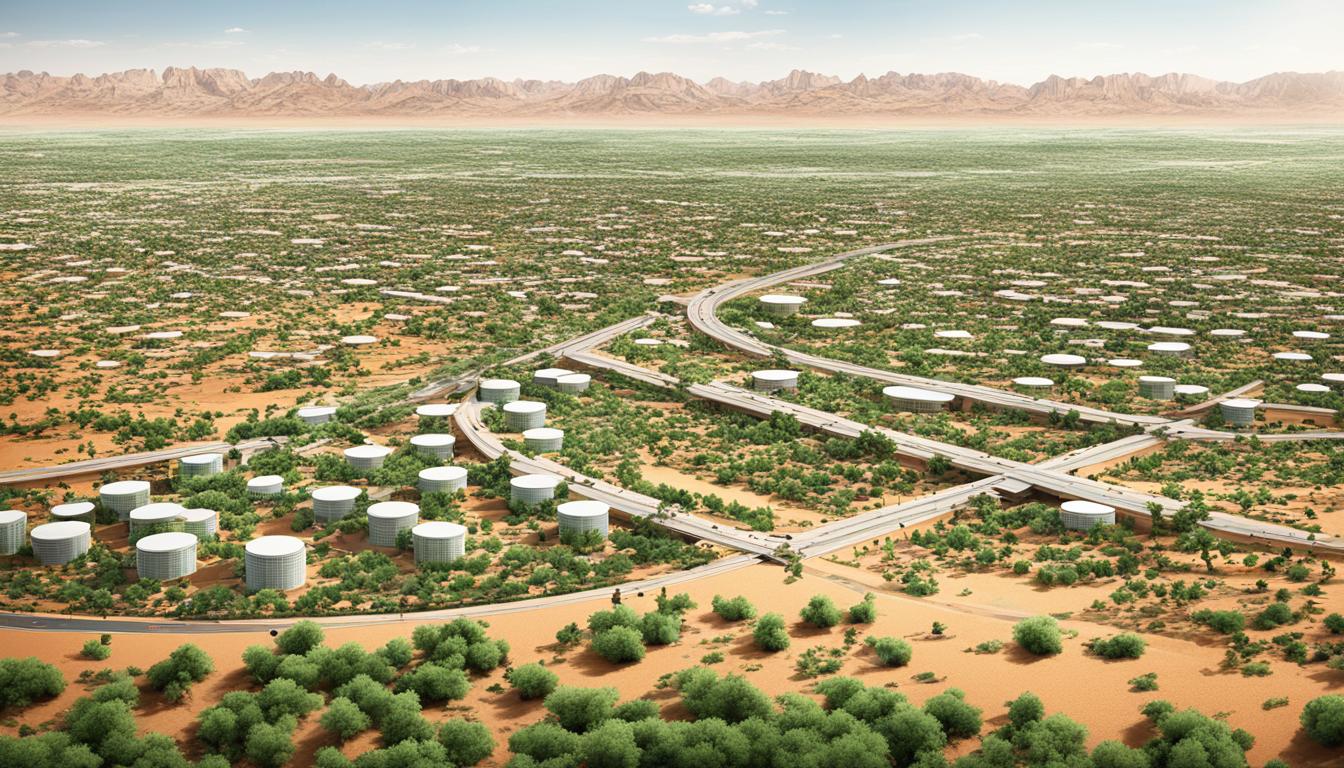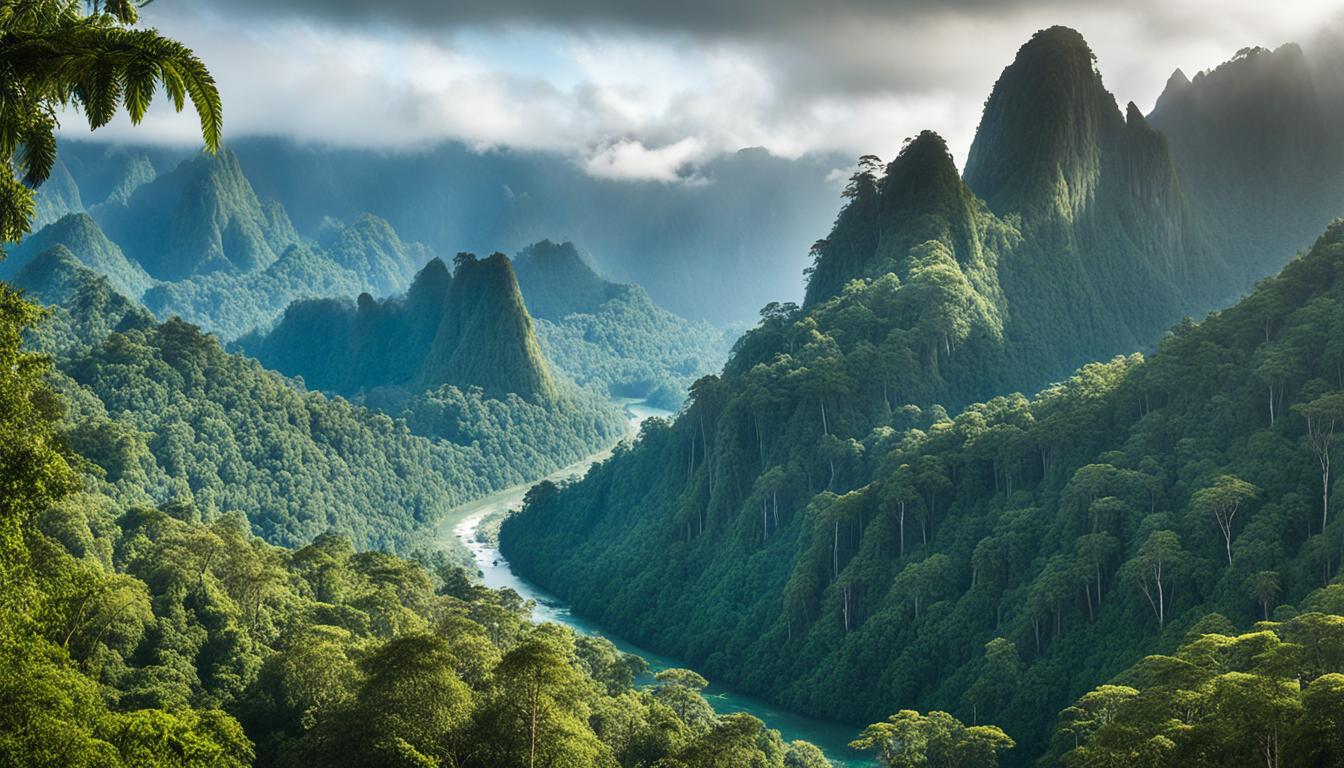Mauritius Biodiversity and the Built Environment
Did you know that Mauritius, a stunning island in the Indian Ocean, is home to an astonishing array of biodiversity?
This small island nation boasts a remarkable level of endemism, with many species found nowhere else in the world. From colourful birds to unique plant species, Mauritius is a biodiversity hotspot that must be safeguarded for future generations.
Key Takeaways:
- Mauritius has a high level of biodiversity, with numerous unique species.
- Preserving and protecting Mauritius’ biodiversity is crucial for sustainable development.
- Conservation efforts are essential to combat threats to Mauritius’ ecosystems.
- The intersection of biodiversity and the built environment requires careful consideration.
- Awareness and action are needed to ensure the long-term survival of Mauritius’ natural treasures.
Importance of Endemic Species in Mauritius
Mauritius is blessed with a remarkable diversity of flora and fauna, much of which is endemic to the island. These endemic species are unique treasures, found nowhere else on Earth. They play a vital role in maintaining the delicate balance of ecosystems and contribute to the overall richness of Mauritius’ biodiversity.
Endemic species have evolved over thousands of years to adapt to the specific environmental conditions of Mauritius. They have developed intricate relationships with their surroundings, and their presence or absence can significantly impact the ecosystem’s stability.
Preserving and protecting these endemic species is of utmost importance for the conservation of Mauritius’ natural heritage. By safeguarding endemic species, we also protect the habitats and ecosystems they rely on. This, in turn, helps maintain the overall health and resilience of Mauritius’ biodiversity.
The Role of Endemic Species in Ecosystem Balance
Endemic species in Mauritius fulfill essential ecological roles. They are often key players in pollination, seed dispersal, and nutrient cycling processes. For example, the Mauritius Bulbul, an endemic bird species, acts as a pollinator for several plant species. Without the Bulbul’s contribution, these plants would struggle to reproduce, resulting in a decline in their populations and potential loss of genetic diversity.
Moreover, endemic species can significantly influence the structure and functioning of ecosystems. By occupying specific niches and consuming certain resources, they help regulate population sizes of other organisms and prevent the domination of a particular species. Their presence ensures a complex web of interactions and enhances the overall resilience of the ecosystem.
Endemic species are crucial for maintaining the ecological balance in Mauritius. Their protection is essential to preserve the island’s unique biodiversity and safeguard the health of its ecosystems.
To truly appreciate the importance of endemic species in Mauritius, one must consider the consequences of their loss. When endemic species become extinct, their ecological roles are left unfulfilled. This can disrupt the delicate equilibrium of the ecosystem, leading to cascading effects on other species and potentially causing widespread decline or even extinction.
Therefore, conserving and restoring the habitats of endemic species is not only crucial for the survival of these unique organisms but also for the overall ecological stability of Mauritius. By protecting endemic species, we ensure a sustainable future where the island’s natural treasures can continue to thrive for generations to come.
Conservation Efforts for Endemic Species
The conservation of endemic species in Mauritius requires dedicated efforts from various stakeholders, including government agencies, NGOs, and local communities. These efforts involve measures such as:
- Creating protected areas and nature reserves to conserve critical habitats.
- Implementing invasive species management programs to control the spread of non-native species that threaten the survival of endemic species.
- Supporting captive breeding and reintroduction programs to boost the populations of critically endangered endemic species.
- Conducting research and monitoring to better understand the needs and threats facing endemic species.
Through these initiatives, we can mitigate the challenges faced by endemic species and provide them with a fighting chance for survival. By acting collectively, we can ensure that Mauritius’ unique biodiversity and the invaluable role of endemic species are preserved for future generations to enjoy.
Threats to Mauritius Biodiversity
Mauritius faces several threats to its biodiversity, including habitat loss, invasive species, pollution, and the impacts of climate change. These threats have led to the extinction of iconic species like the Dodo. Efforts are needed to mitigate these threats and protect Mauritius’ wildlife and ecosystems.
Habitat loss is a significant threat to Mauritius’ biodiversity. As human populations expand and urbanization increases, natural habitats are being destroyed or fragmented, leaving species with limited space to thrive. The destruction of forests, wetlands, and coastal areas not only results in the loss of habitat for endemic plants and animals but also disrupts the delicate balance of ecosystems.
Invasive species also pose a major challenge to Mauritius’ biodiversity. These non-native species, introduced either deliberately or accidentally, outcompete native species for resources and disrupt natural ecosystems. The invasion of plants like the Chinese Guava and animals like the Rats has had devastating effects on the native flora and fauna of the island.
Pollution, both land-based and marine, is another threat to Mauritius’ biodiversity. Pollution from agricultural runoff, industrial activities, and improper waste disposal has contaminated waterways and caused degradation of coastal ecosystems. This pollution negatively impacts marine life, including coral reefs, and threatens the survival of species that depend on these habitats.
The impacts of climate change, such as rising temperatures, sea-level rise, and extreme weather events, also pose a significant threat to Mauritius’ biodiversity. These changes can alter habitats, disrupt breeding patterns, and weaken the resilience of species already under pressure from other threats. Coral bleaching events, for example, have had a detrimental effect on the health and survival of coral reefs, impacting the entire ecosystem that depends on them.
Efforts are essential to mitigate and address these threats to Mauritius’ biodiversity. Conservation measures, such as the creation of protected areas and the restoration of degraded habitats, can help preserve important ecosystems and provide a safe haven for endangered species. Additionally, strict regulations and monitoring systems are needed to control invasive species and reduce pollution levels. The adoption of sustainable practices and the promotion of climate change mitigation strategies are also crucial to safeguard Mauritius’ wildlife and ecosystems for future generations.
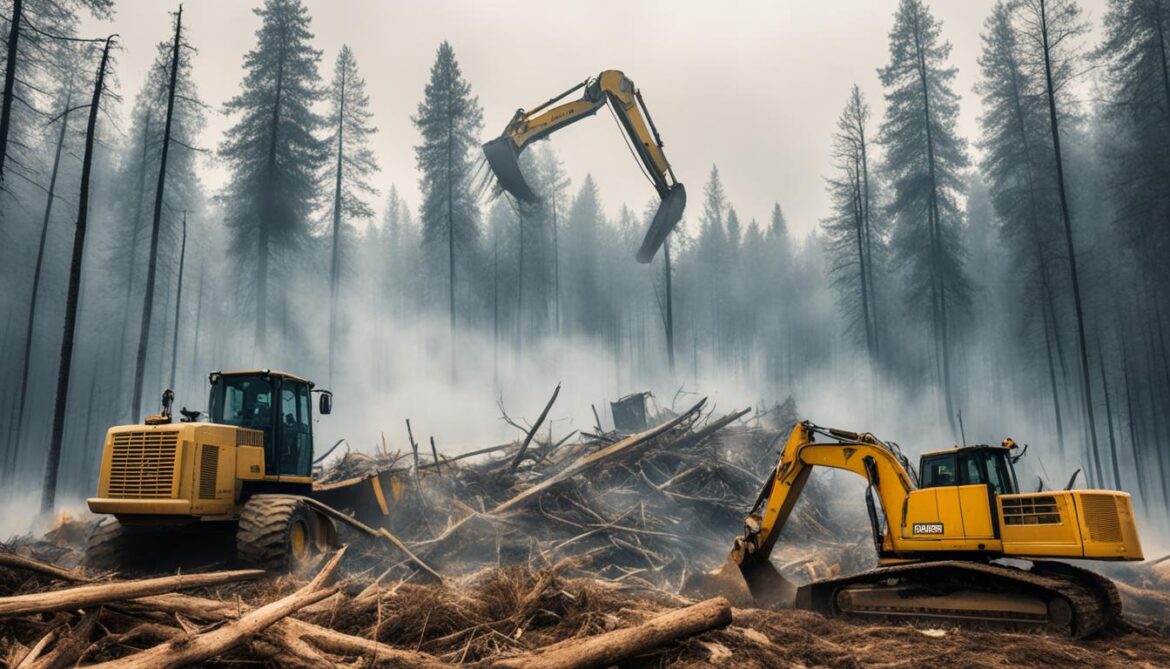
Conservation Efforts in Mauritius
Mauritius has undertaken significant conservation efforts to protect its rich biodiversity and ensure the long-term survival of its unique flora and fauna. These efforts encompass various strategies, including habitat restoration, invasive species management, and climate change mitigation.
Habitat restoration plays a crucial role in preserving the natural habitats of Mauritius’ endemic species. By rehabilitating damaged ecosystems and creating suitable environments, conservationists aim to maintain the delicate balance of biodiversity. One example of successful habitat restoration is the restoration of the Ebony Forest, which provides a sanctuary for endangered plant and animal species.
Invasive species pose a significant threat to Mauritius’ native flora and fauna. Through invasive species management, the government and conservation organizations employ measures to control and eradicate invasive species. These efforts include monitoring, removal programs, and the introduction of biological control measures. To combat invasive species, Mauritius has established the National Parks and Conservation Service, which focuses on protecting the island’s unique ecosystems.
Climate change mitigation is a vital aspect of conservation efforts in Mauritius. The country faces the impacts of rising sea levels, increased temperatures, and extreme weather events. To mitigate these effects, initiatives are underway to reduce carbon emissions, promote renewable energy sources, and implement sustainable practices. By taking proactive measures, Mauritius aims to safeguard its biodiversity and coastal ecosystems from the adverse effects of climate change.
“Conservation efforts in Mauritius encompass habitat restoration, invasive species management, and climate change mitigation. These initiatives are crucial to safeguard the island’s unique biodiversity and ensure a sustainable future for generations to come.”
| Conservation Efforts | Description |
|---|---|
| Habitat Restoration | Rehabilitating damaged ecosystems to preserve endemic species’ natural habitats |
| Invasive Species Management | Implementing measures to control and eradicate invasive species |
| Climate Change Mitigation | Reducing carbon emissions, promoting renewable energy, and implementing sustainable practices to combat the effects of climate change |
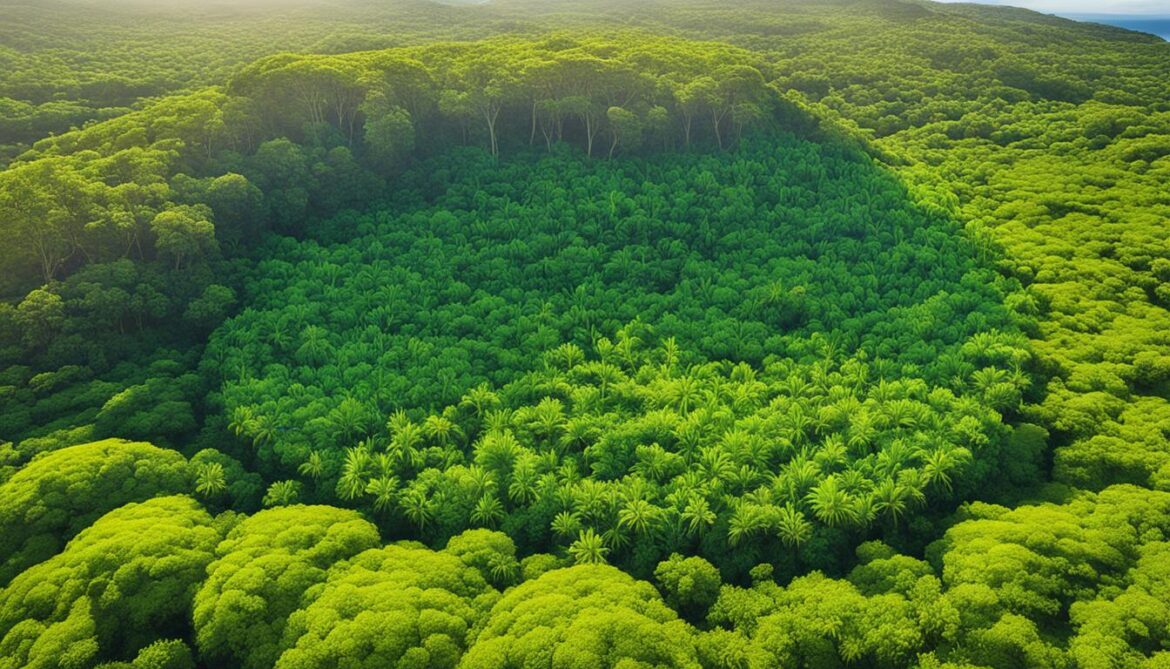
These conservation efforts have led to the establishment of protected areas and marine parks across the island. These protected areas act as sanctuaries for endangered species and enable the restoration of fragile ecosystems. Through a combination of preservation, research, and education, Mauritius aims to raise awareness about the importance of biodiversity and inspire a collective commitment to conservation.
Endangered Species in Mauritius
Mauritius is home to several endangered species that are part of its diverse biodiversity. Among these species are the Mauritius Kestrel and Parakeet, which face numerous threats to their survival.
To protect and preserve these endangered species, conservation organizations like the Mauritian Wildlife Foundation play a vital role. They implement various strategies, including breeding programs and reintroduction initiatives, to ensure the long-term survival of these iconic animals.
The Mauritian Wildlife Foundation, founded in 1984, is dedicated to safeguarding Mauritius’ unique flora and fauna. It works closely with government agencies, local communities, and international partners to promote conservation efforts, protect habitats, and raise awareness about the importance of preserving biodiversity.
The Mauritius Kestrel
The Mauritius Kestrel (Falco punctatus) is one of the most critically endangered birds of prey in the world. Once on the brink of extinction, with only four individuals remaining in the 1970s, conservation efforts have successfully increased their population to around 450 individuals today.
The Mauritius Kestrel is endemic to Mauritius and plays a vital role in the ecosystem as a predator, controlling populations of small vertebrates like geckos and lizards. Its recovery is a testament to the effectiveness of conservation programs and the dedication of organizations like the Mauritian Wildlife Foundation.
The Mauritius Parakeet
The Mauritius Parakeet (Psittacula echo) is another critically endangered species native to Mauritius. With a population of less than 100 individuals, it is one of the rarest parakeets globally.
This vibrant green parakeet plays a crucial role in seed dispersal, helping to maintain the biodiversity of Mauritius’ forests. Conservation efforts focus on habitat restoration, reducing threats from invasive species, and breeding programs to boost the population of these beautiful birds.
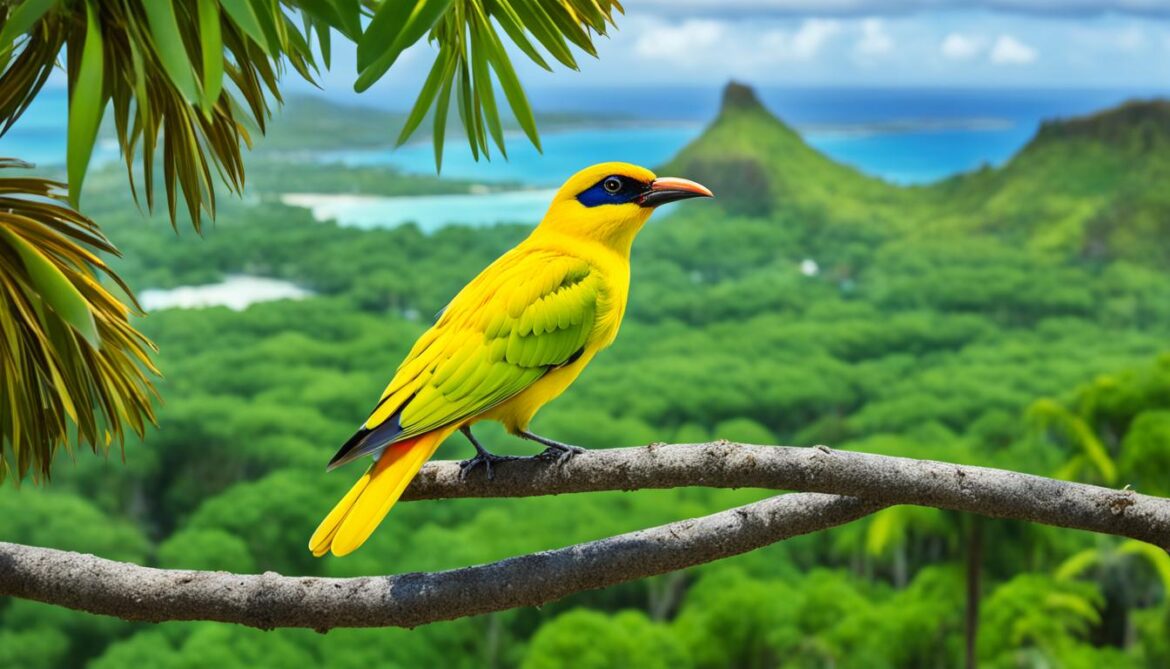
| Endangered Species | Conservation Status |
|---|---|
| Mauritius Kestrel | Critically Endangered |
| Mauritius Parakeet | Critically Endangered |
Marine Biodiversity in Mauritius
Mauritius, surrounded by the vast Indian Ocean, boasts a remarkable marine biodiversity. Its waters are teeming with a diverse array of fish species, enchanting marine mammals, and majestic marine turtles. These magnificent creatures contribute to the vibrant and delicate coastal ecosystems that thrive in Mauritius.
At the heart of the marine biodiversity in Mauritius are the coral reefs. These intricate and vibrant ecosystems serve as vital habitats for a multitude of marine species, providing shelter, food, and breeding grounds. Coral reefs also play a crucial role in protecting coastal areas from erosion and wave action.
However, despite their ecological significance, coral reefs in Mauritius face numerous threats. Sedimentation resulting from human activities, pollution from coastal development, overfishing, and destructive practices pose significant challenges to the health and abundance of these fragile ecosystems.
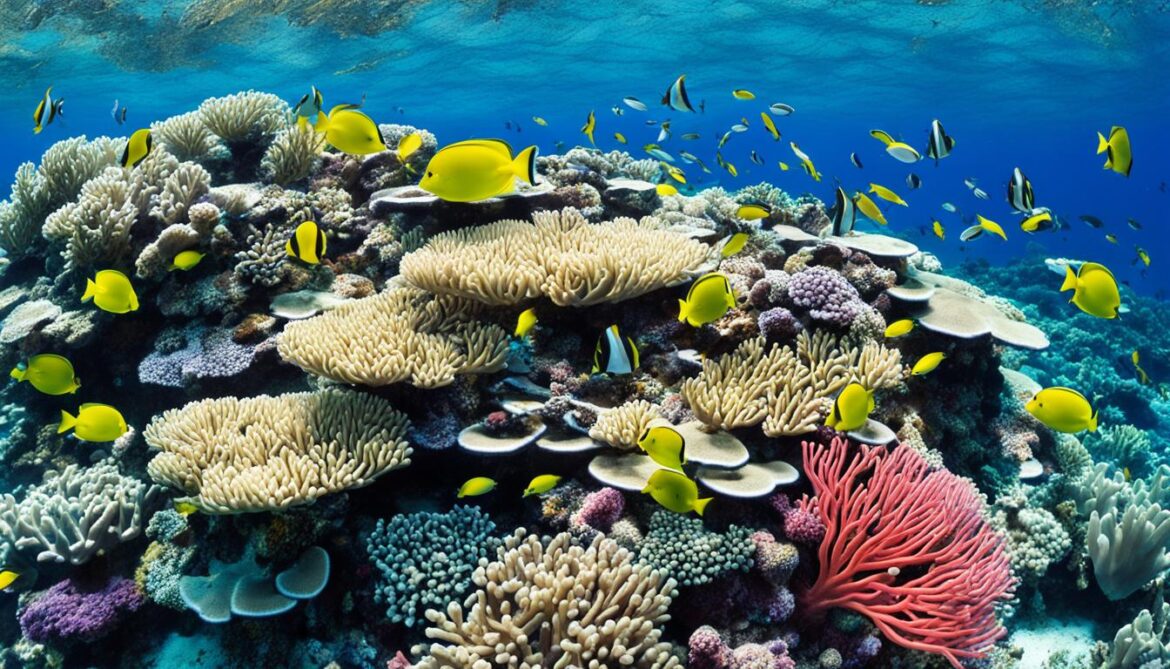
The image above portrays the breathtaking beauty of the coral reefs found in Mauritius, showcasing their vibrant colors and intricate formations. It serves as a reminder of the importance of preserving and safeguarding these invaluable marine ecosystems for future generations.
The Threats to Mauritius’ Coral Reefs
1. Sedimentation: The runoff of sediment from land-based activities, such as agriculture and construction, can smother coral reefs, inhibiting their growth and survival.
2. Pollution: The discharge of pollutants, such as sewage and chemicals, into coastal waters can lead to coral bleaching and the destruction of coral reefs.
3. Overfishing: Unsustainable fishing practices, including the use of destructive methods like blast fishing and cyanide fishing, can deplete fish populations and disrupt the delicate balance of coral reef ecosystems.
4. Destructive Practices: Irresponsible tourism activities, such as anchor damage and excessive diving, can cause physical damage to coral reefs, fragmenting their structures and hindering their ability to recover.
Conservation Efforts and Marine Protected Areas
To address these threats and protect marine biodiversity, Mauritius has established various Marine Protected Areas (MPAs). These designated zones aim to conserve and manage coastal ecosystems, including coral reefs, by implementing regulations and promoting sustainable practices.
Table: Marine Protected Areas in Mauritius
| Marine Protected Area | Location | Size | Year Established |
|---|---|---|---|
| Blue Bay Marine Park | Southeast coast of Mauritius | 353 hectares | 1997 |
| Balaclava and Baie aux Tortues | Northwest coast of Mauritius | 12.4 square kilometers | 2005 |
| Port Mathurin Marine Park | Rodrigues Island | 5.78 square kilometers | 1998 |
These Marine Protected Areas serve as havens for marine species, allowing them to thrive and ensuring the long-term sustainability of Mauritius’ coastal ecosystems. They also create opportunities for eco-tourism, offering visitors the chance to witness the beauty and diversity of marine life in a responsible and sustainable manner.
Marine biodiversity is a treasure that must be protected. Through concerted efforts and responsible actions, we can safeguard the beauty and abundance of coral reefs and coastal ecosystems in Mauritius for generations to come.
Importance of Seed Dispersers in Mauritius
The extinction of native seed dispersers, like the dodo and giant tortoises, has had a significant impact on Mauritius’ biodiversity. These extinct species played a crucial role in the dispersal of seeds, contributing to the survival and distribution of various plant species in the island’s unique ecosystems.
The loss of seed dispersal capacity poses a threat to the survival of many plant species in Mauritius. Without the assistance of these seed dispersers, plants face challenges in colonizing new habitats, which hampers the natural regeneration and diversification of the Mauritius flora and fauna.
Efforts are being made to understand the ecological role of seed dispersers and their impact on the mauritius flora and fauna. Scientists and conservationists are studying the interactions between plants and potential seed dispersers to develop strategies that can restore the seed dispersal mechanism. By reintroducing suitable seed dispersers or finding alternative methods to facilitate seed dispersal, it is hoped that the ecological balance can be restored and the mauritius flora and fauna can thrive once again.
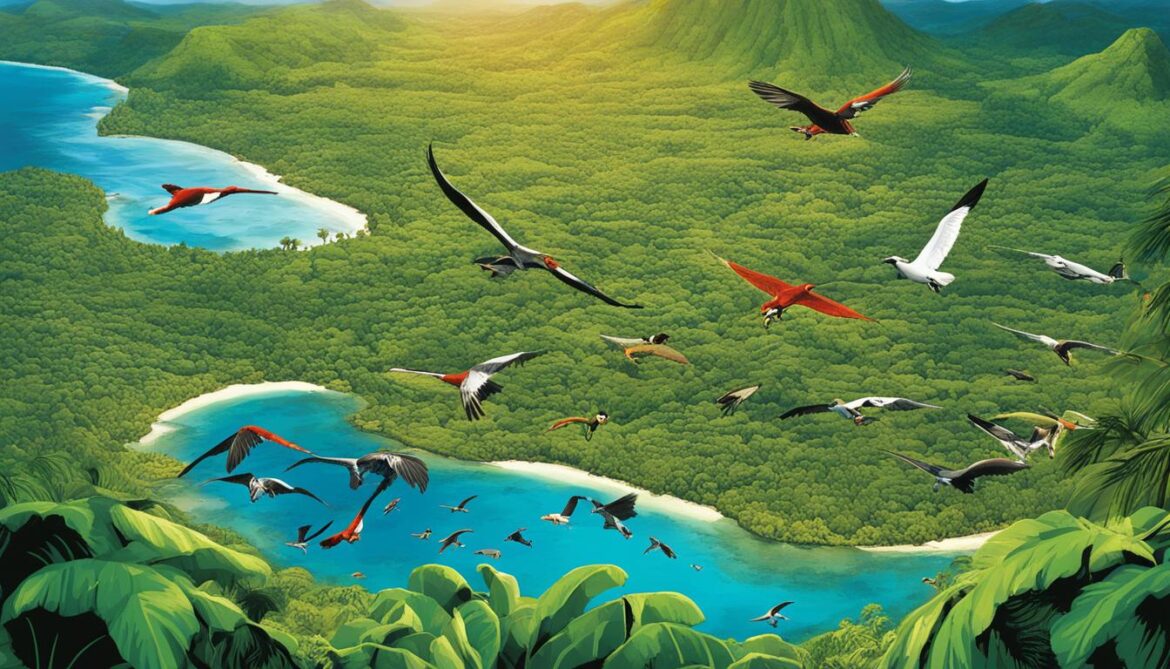
The Role of Extinct Seed Dispersers
The dodo, a flightless bird endemic to Mauritius, was an important seed disperser. Its large size allowed it to consume fruits and deposit the seeds in different locations across the island. The giant tortoises, known for their slow movement, played a similar role in the dispersal of seeds. These extinct species played a vital role in shaping the mauritius flora and fauna as we know it today.
Restoring Seed Dispersal Mechanisms
Restoring the seed dispersal mechanisms in Mauritius is crucial for the conservation of its unique biodiversity. It requires a multi-faceted approach that includes habitat restoration, captive breeding of potential seed dispersers, and raising awareness about the importance of seed dispersal in maintaining healthy ecosystems.
Collaborative Conservation Efforts
Conservation organizations, researchers, and local communities are joining forces to understand and restore the ecological role of seed dispersers. By working together, they aim to preserve the mauritius flora and fauna for future generations and ensure the long-term sustainability of the island’s natural resources.
Environmental Priorities in Mauritius
In Mauritius, addressing environmental priorities is of utmost importance to ensure the long-term sustainability of the island’s natural resources. The country faces significant challenges related to climate change, environmental pollution, and coastal degradation. These issues require immediate attention and strategic actions to mitigate their adverse impacts.
Climate change poses a grave threat to Mauritius, as the country is exposed to natural hazards, including cyclones, rising sea levels, and extreme weather events. These phenomena can result in devastating consequences such as property damage, loss of livelihoods, and threats to human lives. To combat climate change, Mauritius is implementing measures to reduce greenhouse gas emissions, promote renewable energy sources, and enhance climate resilience.
Environmental pollution is another pressing concern in Mauritius. Rapid urbanization, industrial activities, and improper waste management have led to pollution of air, water, and land resources. This pollution negatively affects both human health and the ecological balance. The government, in collaboration with various stakeholders, is working towards effective waste management systems, strict regulations on emissions, and promoting sustainable practices to minimize environmental pollution.
“The pollution of the environment is not a distant problem; it is a present problem that we need to address urgently. Our actions today will shape the future of Mauritius and the well-being of generations to come.”
Coastal degradation is a critical issue for an island nation like Mauritius. The coastal areas provide essential habitats for marine species, protect against erosion, and offer recreational opportunities for locals and tourists. However, uncontrolled development, coral reef destruction, and overfishing have resulted in the degradation of coastal ecosystems. To address this problem, Mauritius is implementing coastal protection measures, promoting sustainable tourism practices, and raising awareness about the importance of preserving these delicate ecosystems.

By prioritizing these environmental concerns, Mauritius is taking significant steps towards a sustainable future. The government’s commitment to developing strategic policies, investing in infrastructure, and fostering partnerships with local communities and international organizations is crucial in combating climate change, reducing pollution, and safeguarding the coastal ecosystems. Through collective efforts, Mauritius aims to preserve its natural heritage and ensure a prosperous and environmentally conscious future for its people.
Conclusion
The preservation of Mauritius biodiversity and the sustainable development of the built environment are inextricably linked. Conservation efforts play a vital role in protecting the unique flora and fauna of the island while ensuring the long-term environmental sustainability.
By raising awareness and implementing effective conservation strategies, we can protect endangered species and their habitats, mitigating the impact of human activities on Mauritius biodiversity. With the right measures in place, we can safeguard the delicate ecosystems that contribute to the country’s natural heritage.
It is imperative that we prioritize the conservation of Mauritius biodiversity to minimize the environmental impact on future generations. Through education, research, and collaboration, we can create a sustainable future where the coexistence of biodiversity and the built environment thrives.
FAQ
What is the importance of endemic species in Mauritius?
Endemic species in Mauritius are unique and contribute to the rich biodiversity of the island. They play a vital role in maintaining the balance of ecosystems and preserving the sustainability of Mauritius’ natural treasures.
What are the threats to Mauritius biodiversity?
The threats to Mauritius biodiversity include habitat loss, invasive species, pollution, and the impacts of climate change. These threats have led to the extinction of iconic species like the Dodo. Efforts are needed to mitigate these threats and protect Mauritius’ wildlife and ecosystems.
What conservation efforts are being made in Mauritius?
Mauritius has implemented various conservation efforts, including habitat restoration, invasive species management, and climate change mitigation. Protected areas and marine parks have been established, and strategies are in place to control invasive species. These efforts aim to safeguard biodiversity and ensure the long-term survival of Mauritius’ unique flora and fauna.
Which endangered species are found in Mauritius?
Mauritius is home to several endangered species, such as the Mauritius Kestrel and Parakeet. Conservation organizations, like the Mauritian Wildlife Foundation, play a vital role in protecting and preserving these endangered species through breeding programs and reintroduction initiatives.
What is the significance of marine biodiversity in Mauritius?
Mauritius has a rich marine biodiversity, with diverse species of fish, marine mammals, and marine turtles. Coral reefs play a crucial role in providing habitats for marine species. However, these ecosystems are threatened by sedimentation, pollution, overfishing, and destructive practices.
How do the extinction of seed dispersers affect Mauritius biodiversity?
The extinction of native seed dispersers, like the dodo and giant tortoises, has had a significant impact on Mauritius’ biodiversity. The loss of seed dispersal capacity poses a threat to the survival of many plant species. Efforts are needed to understand and restore the ecological role of seed dispersers.
What are the environmental priorities in Mauritius?
The major environmental priorities in Mauritius include climate change, environmental pollution, and coastal degradation. The country is exposed to natural hazards and faces water stress. Measures are being taken to address these issues, including the development of strategic policies and investments in infrastructure.
How does the built environment impact Mauritius biodiversity?
The intersection of Mauritius biodiversity and the built environment is crucial for sustainable development. Conservation efforts and awareness are needed to protect endangered species and ecosystems. Preserving the unique biodiversity of Mauritius is essential for the long-term sustainability of the island’s natural resources.




